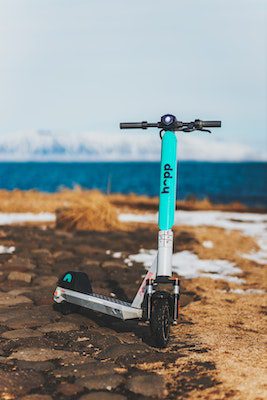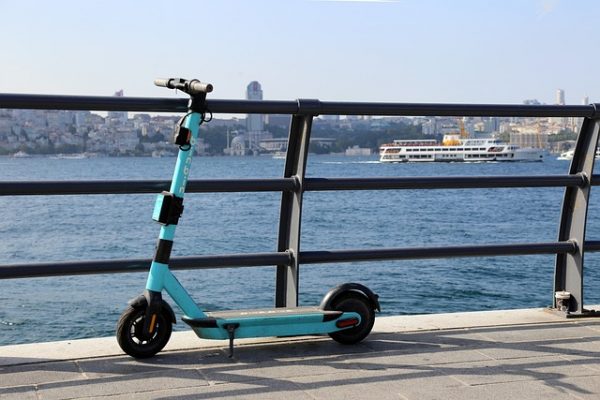
Heading to the beach doesn’t just mean swimming and sunbathing anymore – now you can add scootering to the list of fun seaside activities! Whether you’re riding a gas-powered or electric model, it’s important to understand how to do it securely and responsibly so everybody can enjoy their time by the sea.
In this article, we’ll guide you through choosing the right model for beach riding, preparing your vehicle for sandy terrains, understanding seaside etiquette, mastering sand-riding techniques, adhering to safety measures, and handling unexpected situations. Make the most out of your trip and apply our tips!
As always, it’s important to consider the weight, size, and speed of the model. It’s also good to look for features such as a waterproof deck, powerful motor, and wide tires. These features will help you tackle the sandier terrain without any trouble. Additionally, make sure to double-check the battery life before going out.
When scootering on the beach, it’s important to be aware of your surroundings and follow proper beach etiquette. This includes respecting other beachgoers and staying in areas designated for scootering. It’s also important to ride at a safe speed and avoid weaving in between people or obstacles.
Before you go on a drive, know the necessary techniques. This includes leaning forward to keep your weight over the scooter, avoiding sudden stops and turns, and keeping your speed steady. It’s also important to stay away from water so your vehicle won’t get stuck in the sand or mud.
Safety should always be the priority. Always wear a helmet and other protective gear such as elbow and knee pads. Check weather conditions before you go out and ride during times when there is less foot traffic. Additionally, make sure to carry a spare tire or a repair kit in case of unexpected problems.
At FamilyHype, we want you to enjoy your time at the beach while staying safe. That’s why we’ve compiled this guide to help you safely ride a scooter on the beach. From choosing the right scooter for the beach to mastering sand-riding techniques, we hope this guide will help you make the most out of your beach trip. If you have any feedback or questions, don’t hesitate to reach out to us!
Key Takeaways
So, we’ve learned how to choose the right electric scooter and prepare it for beach riding. We also understand beach etiquette and have mastered sand riding techniques. Additionally, we know how to handle unexpected situations.
It is important to remember that while electric scooters are a part of the larger motorized vehicle class, they possess unique attributes such as speed and maneuverability, and values such as safety and fun. As such, it is paramount to wear protective gear like a helmet and knee pads whenever riding a scooter on the beach.
Let’s enjoy the unique thrill of seaside drives, but let’s do so responsibly. With these tips and a focus on staying protected, managing speed, controlling maneuverability, and having fun, you’ll have a blast while being secured. Happy scooting on the sand!
Choosing The Right Scooter For Beach Riding
When it comes to beach riding, choosing the right scooter is essential.

To make sure you have a smooth and safe ride, consider factors like tire size and durability, designed for tricky beach terrain. Don’t forget about maintenance either – it’s key to keeping your scooter in top condition.
For beach riding, we recommend a motorized or electric scooter. They’re both lightweight, durable, and easy to maintain. Additionally, it has larger tires than gas-powered ones, making them perfect for sandy terrain.
Now that we’ve selected the right beach-friendly scooter, let’s transition into how to properly prepare it for a day on the sandy shores. It’s important to check the brakes, tires, and battery before you head out. Additionally, make sure to bring along some tools for maintenance, such as a tire pressure gauge and a small repair kit
Preparing Your Scooter For Beach Riding
Before hitting the sandy trails, it’s crucial to prep your two-wheeler for the unique challenges that come with seaside cruising. Electric scooters, in particular, must be customized in order to increase their durability and performance on this terrain. Utilize sand-proofing techniques like applying anti-corrosion sprays and installing sand guards. These simple steps ensure a smooth drive while preserving your vehicle’s longevity.
Additionally, check the battery life, tighten all screws, and apply lubricant to any moving parts.
Now that we’ve discussed the importance of preparing your e-scooter for seaside driving, let’s delve into understanding etiquette for a safe and respectful scootering experience on the seafront. For this, we will discuss Safety, Respecting the Environment, and Respecting Other Beachgoers.
Safety includes wearing a helmet, following speed limits, and avoiding wet sand, while respecting the environment means staying on marked trails, avoiding sensitive areas, and leaving no trace. Also, when you ride an electric scooter, wear proper clothing. It’s also recommended that you wear a closed toe shoe if possible. Finally, respecting other beachgoers involves being mindful of other beachgoers’ space and avoiding congested pathways.

Beach Riding Etiquettes
As we explore the exhilarating experience of beach scooter riding, it’s essential that we understand and respect the unwritten rules of the beach. Adhering to official beach regulations not only ensures our safety but also helps maintain a harmonious environment for all beach-goers.
Let’s dive into how we can enjoy this unique activity while being mindful and respectful towards others enjoying their own slice of paradise.
Adhering To Rules
Driving your e-scooter in the sand is a fun and exciting experience, but it’s essential to be aware of and adhere to all important regulations for everyone’s security and sand conservation. Familiarize yourself with local laws and regulations; they’re in place to protect us and the natural beauty that we can enjoy for years to come.
It is encouraged that everyone treat other beach-goers with the same level of respect. Age doesn’t matter, you must treat everyone with respect. It is a public space, after all. Beach regulations typically include rules about noise levels, types of vehicles allowed, and the maximum speed that can be used. When riding your scooter, make sure to stick to the speed limit and be aware of your surroundings.
Additionally, be mindful of the environment, and don’t forget to share your feedback about your experience. By following these guidelines, we can all help keep our beaches safe and enjoyable for everyone.
Respecting Other Beach-goers
You’ve got to keep in mind that you’re sharing this beautiful space with others, so make sure your actions don’t disrupt their enjoyment. This isn’t your home – it’s a public space. Here are four rules for respecting other beach-goers:
- Practice beach etiquette by giving people enough room.
- Maintain noise control, scooters (that aren’t gas powered) can be quite loud.
- Always yield to pedestrians.
- Mind the local wildlife and their habitats.
Next, let’s delve into mastering the nuances of riding on sand.
Sand Riding Techniques
Mastering the art of scootering on sand isn’t just about balance and control. It’s a unique dance with nature that demands respect for its shifting terrain. Let’s explore some balancing tips and delve into sand-drifting techniques to make your experience smoother.
Remember, our aim isn’t just fun but also to ensure safety as we serve others. Up next, let’s discuss crucial protection measures while enjoying seaside drives, keeping in mind that this article isn’t for gas-powered scooters.
Talking about scootering means discussing scooter balancing, sand drifting, and safety measures.
Safety Measures
When it comes to beach riding with scooters, safety is of utmost importance. The primary defense against potential injuries is a helmet, and other protective gear like knee and elbow pads should also be worn.
Preparation is key when dealing with unpredictable beach conditions and not taking safety measures before you operate a scooter can be very dangerous.
When talking about safety, at the top of the list is always wearing a helmet, as well as the need for protective gear, such as knee and elbow pads. Additionally, we will go over the best ways to manage unexpected situations while riding, such as sand drifts, rough terrain, and strong wind gusts.
Those stores that rent out scooters provide helmets for people. In the summer when you go to the beach, it can get very crowded. We don’t want a crash to happen and injure ourselves!
No matter the type of scooter you use, make sure to stay safe and be aware of your surroundings. Wear the correct protective gear, and always have a plan in case of an emergency. By adhering to these safety measures, you can enjoy a safe, fun ride on the beach. A person who is knowledgeable of the preventive measures can avoid getting an injury.
Handling Unexpected Situations
Navigating unexpected challenges while cruising on a scooter can truly test your mettle, yet with the right approach and mindset, it’s possible to turn these hurdles into thrilling elements of your adventure.
When faced with unforeseen obstacles, it’s important to remain calm and address them promptly. Our emergency preparedness and scooter safety resources ensure we can deftly handle any situation thrown our way. By doing so, we not only safeguard ourselves but also serve as responsible members of the scooter community.
Knowing your vehicle’s make, model, and year is important. It would be best if you also were prepared with regard to your protective gear, maintenance, and repair. With the right combination of protective gear, regular maintenance, and emergency preparedness, drivers can ensure they are well-equipped to handle any unexpected situation that comes their way.
Conclusion
We have learned how to choose the right model and how to properly prepare our vehicle and ourselves for seaside drives. Practicing etiquette is always essential. Learning about the different techniques for sand riding is important, too. We also now know how to handle unexpected situations. Remember, safety is paramount – always wear protective gear like a helmet and knee pads.
Scooter riders must always wear a helmet to avoid any serious head injuries. Nobody wants an injury, more so a head injury, right? So wear helmets! Steer clear of the emergency room by practicing these safety tips we’ve shared with you.
Let’s enjoy the unique thrill the seaside brings us, but let’s do so responsibly. We’re sure that with these tips and a focus on speed, maneuverability, security, and fun, you’ll have a blast while staying safe. Enjoy your fun experience!
Frequently Asked Questions (FAQs)
Can You Drive It On Sand?
When talking about scooter safety for beach riding, you must determine what type of sand the beach you’ll be going to have. It is not recommended that you ride on soft sand, as your tires can get stuck. In fact, there are some who offer scooter rentals so you can get to the beach. Renting scooters is pretty cool!

How To Drive A Scooter Safely?
At the top of the list of safety tips is to always wear a helmet. Helmets are always important! Even if it’s falling on the sand, it can still hurt a lot. Observe traffic laws and rules of the road so that when you are beside other vehicles, there will not be any problems.
Is It OK To Drive A Bike On Sand?
Riding on sand can be very hard for your bike. In the event that you have no choice but to use it on the sand, then prepare your tires and gear for it.
How Do You Ride On Sand?
Although you can ride on sand, it is recommended that you don’t since riding on sand is not good. It introduces many small particles into your vehicle which can be bad and might cause an accident.
How Can You Prevent A Scooter Accident?
Like previously mentioned, always wear a helmet and other safety gear as you ride a scooter. A good-quality scooter is also important, if it has cheap components then it can cause an accident. Avoid riding at night and in rough terrain!
How Do I Protect My Scooter From Water Damage?
Other people protect it by covering the parts that have a gap with duct tape. Others use waterproofing spray or sealant. Always keep your scooter dry! Don’t ride it in the rain and be careful when you clean it.
What To Do If You Fall From A Scooty?
If you have injuries that need treatment, seek medical help. Don’t try to endure it on your own. If you are wearing protective gear, then it’s not a problem since you will only be sustaining minor injuries.
Will Sand Damage My Bike?
Yes, it can damage it and wear out your components. If you do use your bike in the sand, you should let it dry then brush the sand off. The sand is abrasive and can cause damage to your bike!
Can Sand Mess Up Your Engine?
Yes, too much sand or dust particles can clog your scooter’s air filter and reduce the airflow to the engine. That can cause overheating and other internal damage to the e-scooter.
Does Sunlight Damage Scooty?
Yes, it can slowly damage your e-scooter. It breaks down the materials of your scooty and of course you will need to replace that when it happens.
DISCLAIMER (IMPORTANT): This information (including all text, images, audio, or other formats on FamilyHype.com) is not intended to be a substitute for informed professional advice, diagnosis, endorsement or treatment. You should not take any action or avoid taking action without consulting a qualified professional. Always seek the advice of your physician or other qualified health provider with any questions about medical conditions. Do not disregard professional medical advice or delay seeking advice or treatment because of something you have read here a FamilyHype.com.